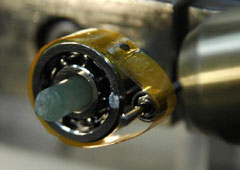 A research team led by professor Tomiki Ikeda at the Tokyo Institute of Technology has developed what is being called the world's first plastic motor powered solely and directly by light.
A research team led by professor Tomiki Ikeda at the Tokyo Institute of Technology has developed what is being called the world's first plastic motor powered solely and directly by light.
Unlike solar-powered motors that use photovoltaic cells to convert light to electric power (and which require wires and batteries to deliver and store the power), this first-of-a-kind motor converts light directly into mechanical energy, thanks to a belt made from a special elastomer whose molecular structure expands or contracts when illuminated, depending on the wavelength of light.
Ikeda began working on the light-activated motor in 2003, after discovering that a plastic compound containing azobenzene would contract when exposed to ultraviolet light and resume its original shape when exposed to visible light. Since then, in addition to working on improving the material's shape-shifting properties, Ikeda's team has been looking at ways to use the material in a motor that converts light directly into motion.
To test whether the material could be used as a mechanical power source, the researchers coated a polyethylene film with the shape-shifting plastic to create a 0.08-millimeter thick belt, which they looped around a pair of wheels measuring 10 millimeters and 3 millimeters in diameter. Then, by shining ultraviolet light on the belt near the smaller wheel and visible light near the larger wheel, the belt snapped into action and began turning the wheels. The larger wheel recorded a top speed of 1 rpm.
According to the researchers, the film demonstrated about 4 times more elastic strength than human muscle, and its strength remained unchanged even after contracting and expanding every 7 seconds for 30 hours.
"The material is still not very efficient at converting light to energy, but it can be improved," says Ikeda, who suggests the shape-shifting plastic can be used in larger-scale applications. He hopes to one day see the material used to power plastic automobiles and other fantastic plastic machines.
The results of the research were published in the July 19 edition of the German chemistry journal Angewandte Chemie.
[Source: Tokyo Shimbun]

Shoovi
This is cool ;)
[]I would say hot and bright news. Really can you imagine impact on electronic and optoelectronic toys we love to use...
Shoovi
I hate trackbacks
[]polywood
This technology has a long way to go before it's going to have any effect on power usage. 1 rpm, come on.... you can get more power from putting a mini-paddlewheel in a stream....
[]Simon Cruz
This is really cool!
[]rastabhang
Need a service directory listing?? You need SaaS - Software as a Service Directory Listing Visit http://www.saaslisting.com/
SaaSListing.com provides an honest look and review into some of the best up and coming SaaS and Technology related websites in the world. Our focus is to offer honest, reliable and quality analysis of businesses that make a difference each and every day. List your startup saas company: Accounting, CRM, CMS, Cloud Computing, Managed Services, HR, IT and more.Delete this site from your blog? or Delete review only
[]